AMD's Radeon HD 5870: Bringing About the Next Generation Of GPUs
by Ryan Smith on September 23, 2009 9:00 AM EST- Posted in
- GPUs
Power, Temperature, & Noise
As we have mentioned previously, one of AMD’s big design goals for the 5800 series was to get the idle power load significantly lower than that of the 4800 series. Officially the 4870 does 90W, the 4890 60W, and the 5870 should do 27W.
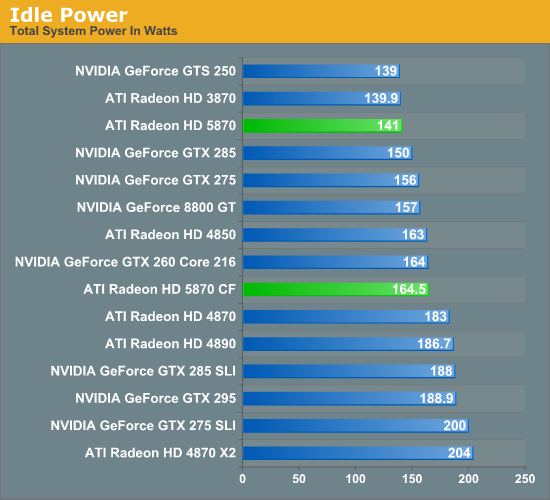
On our test bench, the idle power load of the system comes in at 141W, a good 42W lower than either the 4870 or 4890. The difference is even more pronounced when compared to the multi-GPU cards that the 5870 competes with performance wise, with the gap opening up to as much as 63W when compared to the 4870X2. In fact the only cards that the 5870 can’t beat are some of the slowest cards we have: the GTS 250 and the Radeon HD 3870.
As for the 5870 CF, we see AMD’s CF-specific power savings in play here. They told us they can get the second card down to 20W, and on our rig the power consumption of adding a second card is 23.5W, which after taking power inefficiencies into account is right on the dot.
Moving on to load power, we are using the latest version of the OCCT stress testing tool, as we have found that it creates the largest load out of any of the games and programs we have. As we stated in our look at Cypress’ power capabilities, OCCT is being actively throttled by AMD’s drivers on the 4000 and 3000 series hardware. So while this is the largest load we can generate on those cards, it’s not quite the largest load they could ever experience. For the 5000 series, any throttling would be done by the GPU’s own sensors, and only if the VRMs start to overload.
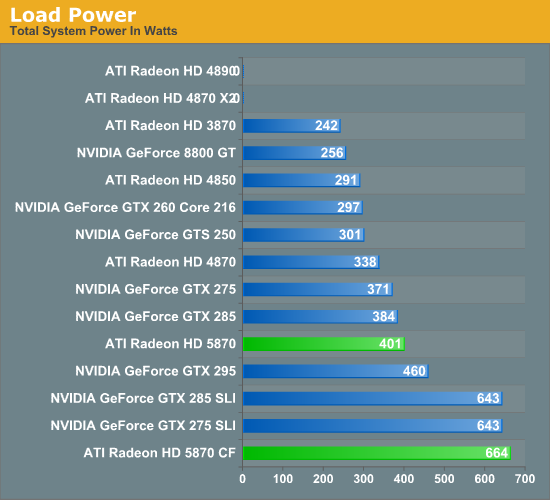
In spite of AMD’s throttling of the 4000 series, right off the bat we have two failures. Our 4870X2 and 4890 both crash the moment OCCT starts. If you ever wanted proof as to why AMD needed to move to hardware based overcurrent protection, you will get no better example of that than here.
For the cards that don’t fail the test, the 5870 ends up being the most power-hungry single-GPU card, at 401W total system power. This puts it slightly ahead of the GTX 285, and well, well behind any of the dual-GPU cards or configurations we are testing. Meanwhile the 5870 CF takes the cake, beating every other configuration for a load power of 664W. If we haven’t mentioned this already we will now: if you want to run multiple 5870s, you’re going to need a good power supply.
Ultimately with the throttling of OCCT it’s difficult to make accurate predictions about all possible cases. But from our tests with it, it looks like it’s fair to say that the 5870 has the capability to be a slightly bigger power hog than any previous single-GPU card.
In light of our results with OCCT, we have also taken load power results for our suite of cards when running World of Warcraft. As it’s not a stress-tester it should produce results more in line with what power consumption will look like with a regular game.

Right off the bat, system power consumption is significantly lower. The biggest power hogs are the are the GTX 285 and GTX 285 SLI for single and dual-GPU configurations respectively. The bulk of the lineup is the same in terms of what cards consume more power, but the 5870 has moved down the ladder, coming in behind the GTX 275 and ahead of the 4870.
Next up we have card temperatures, measured using the on-board sensors of the card. With a good cooler, lower idle power consumption should lead to lower idle temperatures.
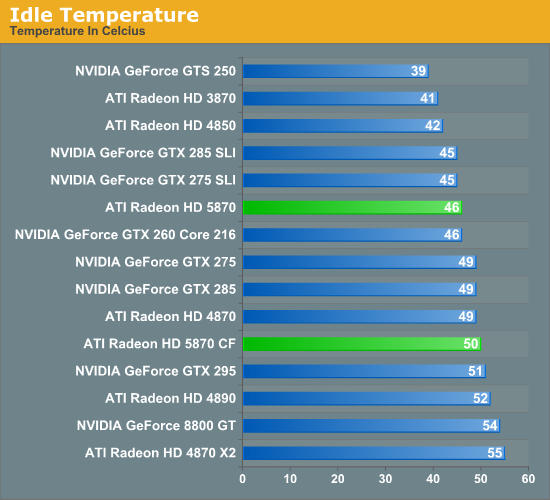
The floor for a good cooler looks to be about 40C, with the GTS 250, 3870, and 4850 all turning in temperatures around here. For the 5870, it comes in at 46C, which is enough to beat the 4870 and the NVIDIA GTX lineup.
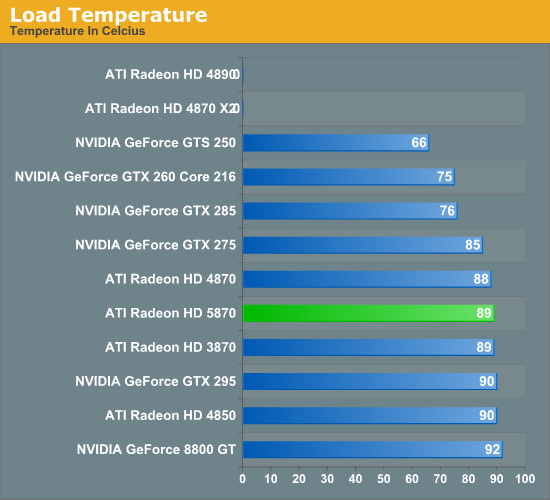
Unlike power consumption, load temperatures are all over the place. All of the AMD cards approach 90C, while NVIDIA’s cards are between 92C for an old 8800GT, and a relatively chilly 75C for the GTX 260. As far as the 5870 is concerned, this is solid proof that the half-slot exhaust vent isn’t going to cause any issues with cooling.
Finally we have fan noise, as measured 6” from the card. The noise floor for our setup is 40.4 dB.

All of the cards, save the GTX 295, generate practically the same amount of noise when idling. Given the lower energy consumption of the 5870 when idling, we had been expecting it to end up a bit quieter, but this was not to be.
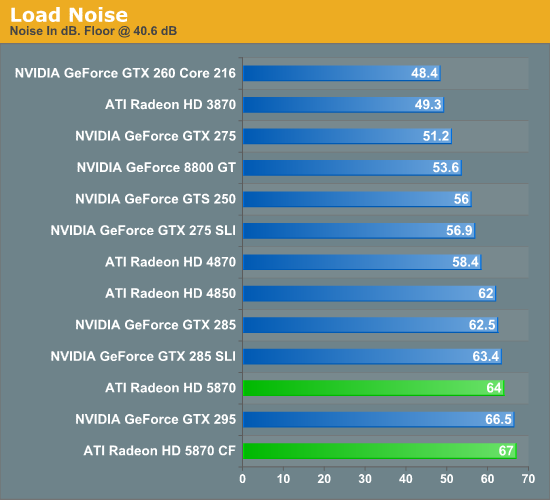
At load, the picture changes entirely. The more powerful the card the louder it tends to get, and the 5870 is no exception. At 64 dB it’s louder than everything other than the GTX 295 and a pair of 5870s. Hopefully this is something that the card manufacturers can improve on later on with custom coolers, as while 64 dB at 6" is not egregious it’s still an unwelcome increase in fan noise.










327 Comments
View All Comments
Scali - Thursday, October 1, 2009 - link
Here's a screenshot of my 8800GTS320 getting almost 49 fps when I overclock it:http://bohemiq.scali.eu.org/OceanCS8800GTS.png">http://bohemiq.scali.eu.org/OceanCS8800GTS.png
So you see why I think 47 fps for a GTX285 is weird. It should easily beat the 72 fps of the HD5870. Even an 8800Ultra might get close to that number.
mapesdhs - Tuesday, September 29, 2009 - link
I sincerely nope not as we need the competition. See:
http://www.marketwatch.com/story/does-amd-really-p...">http://www.marketwatch.com/story/does-a...-pose-a-...
Ian.
Johnwo - Monday, September 28, 2009 - link
so wait, can this card play Crysis?vsl2020 - Sunday, September 27, 2009 - link
AMD only introducing new things which merely would make yur frap fps go 1000 and thats it.....no new good or interesting features such as what nvidia did with physx/3d Stereoscopic or similar that would convince me thats the way to the future...why should I need to buy a new dx11gpu only can do 1000fps...I would still luv my 260+ and 60fps in batman arkhum or other games which supported phsyx or similar...AMD just bring us back to the stone age race ..who has the higher fps race......
Jamahl - Tuesday, September 29, 2009 - link
did you even read the review? what about eyefinity, you know a good way to use up those 1000fps by adding more screens?you can be stuck with your 260, you aren't really gaming unless you are gaming on eyefinity.
Zool - Monday, September 28, 2009 - link
Actualy the delaying of nvidia dx11 card will make introducing new things harder. DX11 and OpenCL means enough that u can forget nvidias physx. At least with open platform dewelopers could finaly merge gpu and cpu code and make some more usefull things than improwed water splashing,unrealistic glass shatering and curtains which just run on top of the code and act as some kind of postprocessing + efects just to maintain compatibility.(miles away from the nvidia demos)And also dx11 compute shader can make these things.
RNViper - Sunday, September 27, 2009 - link
Hey GuysNeed Eyefinity a Nativ DisplayPort TFT?
pawaniitr - Sunday, September 27, 2009 - link
maybe a 2 GiB memory will help this card at highest resolutionswaiting for that version
Troll Trolling - Saturday, September 26, 2009 - link
I think you guys from anandtech could do an article explaining why the new Radeons don't don't double performance, even with doubled specs.It happened too with the HD 4870, it had more than doubled everything (except bandwidht, that was 80% higher) and was not close from double performance.
SiliconDoc - Saturday, September 26, 2009 - link
PS - The bandwidth is not doubled.124GB/sec to 153GB/sec, nowhere near an 80% increasse, let alone, virtually double.